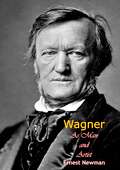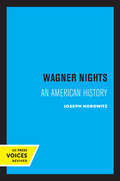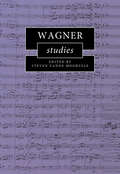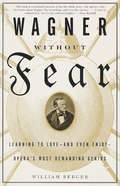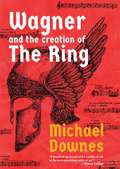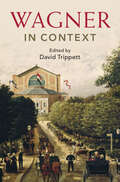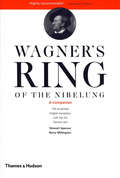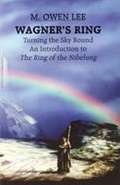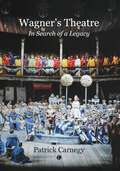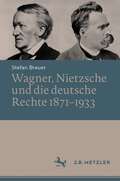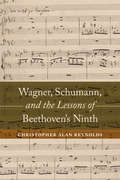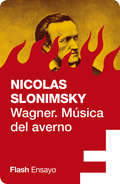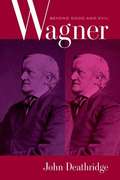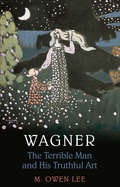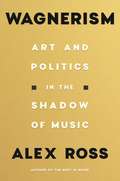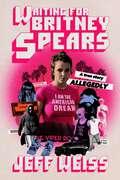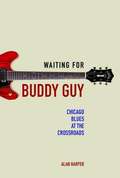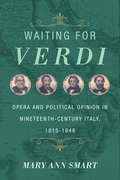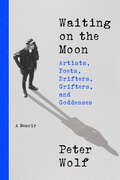- Table View
- List View
Wagner As Man and Artist (Cambridge Library Collection - Music Ser.)
by Ernest NewmanERNEST NEWMAN was born in 1868. Educated at Liverpool College and Liverpool University, he had intended to enter the Indian Civil Service, but when his health broke down, he went instead, into business in Liverpool. In 1905 he became music critic of the Manchester Guardian and subsequently of the Birmingham Post. In 1920 he began his long career as music critic for the Sunday Times (London). Mr. Newman has written, translated, and edited numerous books, among which are his stories of the Great Operas (Volume I and II available in the Vintage series), and his celebrated four-volume biography The Life of Richard Wagner (1933, 1937, 1941, 1946). He died on July 7, 1959.“By all odds, this is Newman’s best full-length book—a triumph of concise biography.”—Jacques BarzunWagner as Man and Artist remains by far the best general introduction to the composer, because Newman admiration for the music did not blind him to the man’s unappealing character, nor to the slim value of his pronouncements on extra-musical matters;—Peter Heyworth in The Observer (London)
Wagner Nights: An American History (California Studies in 19th-Century Music #9)
by Joseph HorowitzAs never before or since, Richard Wagner's name dominated American music-making at the close of the nineteenth century. Europe, too, was obsessed with Wagner, but—as Joseph Horowitz shows in this first history of Wagnerism in the United States—the American obsession was unique. The central figure in Wagner Nights is conductor Anton Seidl (1850-1898), a priestly and enigmatic personage in New York musical life. Seidl's own admirers included the women of the Brooklyn-based Seidl Society, who wore the letter "S" on their dresses. In the summers, Seidl conducted fourteen times a week at Brighton Beach, filling the three-thousand-seat music pavilion to capacity. The fact that most Wagnerites were women was a distinguishing feature of American Wagnerism and constituted a vital aspect of the fin-de-siècle ferment that anticipated the New American Woman. Drawing on the work of such cultural historians as T. Jackson Lears and Lawrence Levine, Horowitz's lively history reveals an "Americanized" Wagner never documented before. An entertaining and startling read, a treasury of operatic lore, Wagner Nights offers an unprecedented revisionist history of American culture a century ago. This title is part of UC Press's Voices Revived program, which commemorates University of California Press’s mission to seek out and cultivate the brightest minds and give them voice, reach, and impact. Drawing on a backlist dating to 1893, Voices Revived makes high-quality, peer-reviewed scholarship accessible once again using print-on-demand technology. This title was originally published in 1994.
Wagner Studies (Cambridge Composer Studies)
by Steven Vande MoorteleWhile the music of Richard Wagner has long served as a touchstone for music-theoretical and analytical models both old and new, music analysts have often been intimidated by the complexity of his works, their multi-layeredness, and their sheer unwieldiness. This volume brings together ten contributions from an international roster of leading Wagner scholars of our time, all of which engage in some way with analytical or theoretical questions posed by Wagner's music. Addressing the operas and music dramas from Die Feen through Parsifal, they combine analytical methods including form-functional theory, Neo-Riemannian theory, Leitmotiv analysis, and history of theory with approaches to dramaturgy, hermeneutics, reception history, and discursive analysis of sexuality and ideology. Collectively, they capture the breadth of analytical studies of Wagner in contemporary scholarship and expand the reach of the field by challenging it to break new interpretative and methodological ground.
Wagner Without Fear: Learning To Love--And Even Enjoy--Opera's Most Demanding Genius
by William BergerDo you cringe when your opera-loving friends start raving about the latest production of Tristan? Do you feel faint just thinking about the six-hour performance of Parsifal you were given tickets to? Does your mate accuse you of having a Tannhäuser complex? If you're baffled by the behavior of Wagner worshipers, if you've longed to fathom the mysteries of Wagner's ever-increasing popularity, or if you just want to better understand and enjoy the performances you're attending, you'll find this delightful book indispensable. William Berger is the most helpful guide one could hope to find for navigating the strange and beautiful world of the most controversial artist who ever lived. He tells you all you need to know to become a true Wagnerite--from story lines to historical background; from when to visit the rest room to how to sound smart during intermission; from the Jewish legend that possibly inspired Lohengrin to the tragic death of the first Tristan. Funny, informative, and always a pleasure to read,Wagner Without Fearproves that the art of Wagner can be accessible to everyone. Includes: - The strange life of Richard Wagner--German patriot (and exile), friend (and enemy) of Liszt and Nietzsche - Essential opera lore and "lobby talk" - A scene-by-scene analysis of each opera - What to listen for to get the most from the music - Recommended recordings, films, and sound tracks
Wagner and the Creation of the Ring
by Michael DownesPart cultural history, part biography, this is the fascinating story of Richard Wagner&’s life, influences, gift for storytelling, and artistic revolution, culminating in the dramatic journey to write The Ring Cycle.The Ring Cycle is one of the most epic and compelling operas of the nineteenth century, created by a composer who was, alongside Dickens, Tolstoy, and Victor Hugo, also one of the century&’s master storytellers. But the story of how Richard Wagner created the work is one full of intrigue and triumphs against unlikely odds—as well as controversy, due to the composer&’s anti-semitic views and popularity with the Nazi party. In Wagner and the Creation of the Ring, Michael Downes combines cultural history and biography to recount the colorful, fascinating, and insightful journey behind the creation of The Ring and its mythology. He tells the story of how and why this extraordinary masterpiece came into being, why it takes the form it does, why it fascinates and obsesses so many—and horrifies others—and why it still matters today.
Wagner and the Erotic Impulse
by Laurence DreyfusThough his image is tarnished today by unrepentant anti-Semitism, Richard Wagner (1813–1883) was better known in the nineteenth century for his provocative musical eroticism. In this illuminating study of the composer and his works, Laurence Dreyfus shows how Wagner’s obsession with sexuality prefigured the composition of operas such as Tannhäuser, Die Walküre, Tristan und Isolde, and Parsifal. Daring to represent erotic stimulation, passionate ecstasy, and the torment of sexual desire, Wagner sparked intense reactions from figures like Baudelaire, Clara Schumann, Nietzsche, and Nordau, whose verbal tributes and censures disclose what was transmitted when music represented sex. Wagner himself saw the cultivation of an erotic high style as central to his art, especially after devising an anti-philosophical response to Schopenhauer’s “metaphysics of sexual love.” A reluctant eroticist, Wagner masked his personal compulsion to cross-dress in pink satin and drench himself in rose perfumes while simultaneously incorporating his silk fetish and love of floral scents into his librettos. His affection for dominant females and surprising regard for homosexual love likewise enable some striking portraits in his operas. In the end, Wagner’s achievement was to have fashioned an oeuvre which explored his sexual yearnings as much as it conveyed—as never before—how music could act on erotic impulse.
Wagner in Context (Composers in Context)
by David TrippettFew composers embodied wider cultural interests than Wagner or had greater cultural consequences. This is the first collection to examine directly the rich array of intellectual, social and cultural contexts within which Wagner worked. Alongside fresh accounts of historical topics, from spa culture to racial theory, sentient bodies to stage technology, America to Spain, it casts an eye forward to contexts of Wagner's ongoing reception, from video gaming to sound recording, Israel to Friedrich Kittler, and twenty-first century warfare. The collection brings together an international cast of leading authorities and new voices. Its 42 short chapters offer a reader-friendly way into Wagner studies, with authoritative studies of central topics set alongside emerging new fields. It sheds new light on previously neglected individuals such as Minna Wagner, Theodor Herzl and Houston Stewart Chamberlain, and investigates/assesses/examines the global circulation of Wagner's works, his approach to money, and the controversies that continue to accompany him.
Wagner in Russia, Poland and the Czech Lands: Musical, Literary and Cultural Perspectives
by Anastasia Belina-Johnson Stephen MuirRichard Wagner has arguably the greatest and most long-term influence on wider European culture of all nineteenth-century composers. And yet, among the copious English-language literature examining Wagner's works, influence, and character, research into the composer’s impact and role in Russia and Eastern European countries, and perceptions of him from within those countries, is noticeably sparse. Wagner in Russia, Poland and the Czech Lands aims to redress imbalance and stimulate further research in this rich area. The eight essays are divided in three parts - one each on Russia, the Czech lands and Poland - and cover a wide historical span, from the composer’s first contacts with and appearances in these regions, through to his later reception in the Communist era. The contributing authors examine his influences in a wide range of areas such as music, literary and epistolary heritage, politics, and the cultural histories of Russia, the Czech lands, and Poland, in an attempt to establish Wagner’s place in a part of Europe not commonly addressed in studies of the composer.
Wagner's Melodies
by David TrippettSince the 1840s, critics have lambasted Wagner for lacking the ability to compose melody. But for him, melody was fundamental – 'music's only form'. This incongruity testifies to the surprising difficulties during the nineteenth century of conceptualizing melody. Despite its indispensable place in opera, contemporary theorists were unable even to agree on a definition for it. In Wagner's Melodies, David Trippett re-examines Wagner's central aesthetic claims, placing the composer's ideas about melody in the context of the scientific discourse of his age: from the emergence of the natural sciences and historical linguistics to sources about music's stimulation of the body and inventions for 'automatic' composition. Interweaving a rich variety of material from the history of science, music theory, music criticism, private correspondence and court reports, Trippett uncovers a new and controversial discourse that placed melody at the apex of artistic self-consciousness and generated problems of urgent dimensions for German music aesthetics.
Wagner's Ring Cycle and the Greeks
by Daniel H. FosterVolumes for Cambridge Studies in Opera explore the cultural, political, and social influences of the genre. As a cultural art form, opera is not produced in a vacuum. Rather, it is influenced, whether directly or in more subtle ways, by its social and political environment. In turn, opera leaves its mark on society and contributes to shaping the cultural climate.
Wagner's Ring of the Nibelung: A Companion
by Stewart Spencer Barry Millington"Scrupulous . . . planned and executed with quite unusual care." —Opera There has long been a need for a modern English translation of Wagner's Ring—a version that is reliable and readable yet at the same time is a true reflection of the literary quality of the German libretto. This acclaimed translation, which follows the verse form of the original exactly, fills that niche. It reads smoothly and idiomatically, yet is the result of prolonged thought and deep background knowledge. The translation is accompanied by Stewart Spencer's introductory essay on the libretto and a series of specially commissioned texts by Barry Millington, Roger Hollinrake, Elizabeth Magee and Warren Darcy that discuss the cycle's musical structure, philosophical implications, medieval sources and Wagner's own changing attitude to its meaning. With a glossary of names, a review of audio and video recordings, and a select bibliography, the book is an essential complement to Wagner's great epic.
Wagner's Ring: Turning the Sky Around - An Introduction to the Ring of The Nibelung
by M. Owen LeeShort synopses and analyses of Wagner's Ring cycle by a knowledgeable and thoughtful opera lover who delivered talks on the Metropolitan Opera broadcasts. This is an excellent and short introduction to the Ring. You'll learn the story and also learn something of the philosophical underpinnings of the work. The author also includes short reviews of other literary commentators on the Ring and some of the major recordings up to 1994 when this work was last published.
Wagner's Theatre: In Search of a Legacy
by Patrick CarnegyIn Wagner's Theatre, Patrick Carnegy presents the turbulent story of Wagner and his interpreters over the course of the twentieth century. Carnegy gives vivid accounts of Gustav Mahler's radical reinvention of the Wagnerian stage, and of the post-war rehabilitation of Wagner and his work after Hitler's appropriation. He also offers sharply written reappraisals of those great Wagnerian conductors Klemperer, Toscanini, Karajan and Solti. Carnegy provides revealing accounts of the inside-workings of the Royal Opera House and of English National Opera at troubled points in their recent history. In a fascinating conversation with Sir Michael Tippett, the composer talks with unique authority about the problems facing would-be musical dramatists today. Wagner's Theatre is an essential insight into how interpretations of Wagner have developed, and how we can respond to them.
Wagner, Nietzsche und die deutsche Rechte 1871–1933
by Stefan BreuerDieses Buch befasst sich mit der Wirkung Richard Wagners und Friedrich Nietzsches auf die Ideologien der radikalen Rechten, die in der einen oder anderen Form Eingang in die Sammlungsbewegung des Nationalsozialismus gefunden haben. Es konzentriert sich also auf die Rezeption durch die intellektuelle Rechte des Kaiserreichs und der Weimarer Republik, die zur Analyse des Nationalsozialismus wie der neuen Rechten durch die Erhellung der Vorgeschichte der Ideologien beiträgt. Zwei Kapitel widmen sich dem theoretischen Werk Wagners und dem Werk Nietzsches und den Beziehungen der beiden Leitfiguren des späten 19. Jahrhunderts untereinander.
Wagner, Schumann, and the Lessons of Beethoven's Ninth
by Christopher Alan ReynoldsIn this original study, Christopher Alan Reynolds examines the influence of Beethoven's Ninth Symphony on two major nineteenth-century composers, Richard Wagner and Robert Schumann. During 1845-46 the compositional styles of Schumann and Wagner changed in a common direction, toward a style that was more contrapuntal, more densely motivic, and engaged in processes of thematic transformation. Reynolds shows that the stylistic advances that both composers made in Dresden in 1845-46 stemmed from a deepened understanding of Beethoven's techniques and strategies in the Ninth Symphony. The evidence provided by their compositions from this pivotal year and the surrounding years suggests that they discussed Beethoven's Ninth with each other in the months leading up to the performance of this work, which Wagner conducted on Palm Sunday in 1846. Two primary aspects that appear to have interested them both are Beethoven's use of counterpoint involving contrary motion and his gradual development of the "Ode to Joy" melody through the preceding movements. Combining a novel examination of the historical record with careful readings of the music, Reynolds adds further layers to this argument, speculating that Wagner and Schumann may not have come to these discoveries entirely independently of each other. The trail of influences that Reynolds explores extends back to the music of Bach and ahead to Tristan and Isolde, as well as to Brahms's First Symphony.
Wagner. Música del averno (Flash Ensayo)
by Nicolas SlonimskyNicolas Slonimsky nos presenta aquí un delicioso recopilatorio de descarnadas, venenosas e ingeniosas críticas musicales al compositor Richard Wagner. «Esta música solo puede despertar los instintos más bajos. La música de Wagner invoca al cerdo más que al ángel. Y lo que es peor, ensordece a ambos. Es música de un eunuco enloquecido.»Le Figaro, París, 26 de julio de 1876. «La música de Wagner es la que más me gusta. Suena tan fuerte que uno puede hablar todo el tiempo sin que nadie oiga lo que dice.»Oscar Wilde Este compendio de críticas a Wagner aparece en el libroRepertorio de vituperios musicales (Taurus, 2016).
Wagner: Beyond Good and Evil
by John DeathridgeJohn Deathridge presents a different and critical view of Richard Wagner based on recent research that does not shy away from some unpalatable truths about this most controversial of composers in the canon of Western music.
Wagner: Terrible Man & His Truthful Art
by M. Owen LeeHow is it possible for a seriously flawed human being to produce art that is good, true, and beautiful. Why is the art of Richard Wagner, a very imperfect man, important and even indispensable to us?In this volume, Father Owen Lee ventures an answer to those questions by way of a figure in Sophocles - the hero Philoctetes. Gifted by his god with a bow that would always shoot true to the mark, and indispensable to his fellow Greeks, he was marked by the same god with an odious wound that made him hateful and hated. Sophocles's powerful insight is that those blessed by the gods and indispensable to men are visited as well with great vulnerability and suffering.Wagner: The Terrible Man and His Truthful Art traces some of Wagner's extraordinary influence for good and ill on a century of art and politics - on Eliot and Proust as well as on Adolf Hitler - and discusses in detail Wagner's Tannhauser, the work in which the composer first dramatised the Faustian struggle of a creative artist in whom 'two souls dwell.' In the course of this penetrating study, Father Lee argues that Wagner's ambivalent art is indispensable to us, life-enhancing and ultimately healing.
Wagnerism: Art And Politics In The Shadow Of Music
by Alex RossFor better or worse, Richard Wagner is the most widely influential figure in the history of music. Around 1900, the phenomenon known as Wagnerism saturated European and American culture. Such colossal creations as The Ring of the Nibelung, Tristan und Isolde, and Parsifal were models of formal daring, mythmaking, erotic freedom, and mystical speculation. A mighty procession of artists, including Virginia Woolf, Thomas Mann, Paul Cézanne, Isadora Duncan, and Luis Buñuel, felt the composer's impact. Anarchists, occultists, feminists, and gay-rights pioneers saw him as a kindred spirit. Then Adolf Hitler incorporated Wagner into the soundtrack of Nazi Germany, and the composer came to be defined by his ferocious antisemitism. For many, his name is now almost synonymous with artistic evil. In Wagnerism, Alex Ross restores the magnificent confusion of what it means to be a Wagnerian. A pandemonium of geniuses, charlatans, and prophets does battle over Wagner's many-sided legacy. As readers of his brilliant articles for The New Yorker have come to expect, Ross ranges thrillingly across artistic disciplines, from the architecture of Louis Sullivan to the novels of Philip K. Dick, from the Zionist writings of Theodor Herzl to the civil-rights essays of W. E. B. Du Bois, from O Pioneers! to Apocalypse Now. In many ways, Wagnerism tells a tragic tale. An artist who might have rivaled Shakespeare in universal reach is undone by an ideology of hate. Still, his shadow lingers over twenty-first-century culture, his mythic motifs coursing through superhero films and fantasy fiction. Neither apologia nor condemnation, Wagnerism is a work of passionate discovery, urging us toward a more honest idea of how art acts in the world. ALEX ROSS has been the music critic of The New Yorker since 1996. His first book, the international bestseller The Rest Is Noise: Listening to the Twentieth Century, was a finalist for the Pulitzer Prize and won a National Book Critics Circle Award. His second book, the essay collection Listen to This, received an ASCAP Deems Taylor Award. He was named a MacArthur Fellow in 2008 and a Guggenheim Fellow in 2015.
Waiting for Britney Spears: A True Story, Allegedly
by Jeff WeissAN LA TIMES BESTSELLER. Named a Most Anticipated Book by People, Vulture, A.V. Club and OurCulture."Like a J.D. Salinger novel rolled in Hunter S. Thompson's hallucinogen dust." —Ann Powers, author of Travelling: On the Path of Joni Mitchell"[Waiting for Britney Spears] transformed and transported me." ―Hanif Abdurraqib, author of There's Always This YearA frenetic, gonzo account of Britney Spears’s historic rise and equally tragic fall told by an iconoclastic music journalist.America, 2003: A country at war, its shiny veneer beginning to crack. Von Dutch and The Simple Life dominate. And on the cover of every magazine, a twenty-one-year-old pop star named Britney Spears. Tracking her every move for a third-tier gossip rag in Los Angeles was an unknown young writer taking whatever job he could while pursuing his distant literary dreams. He'd instead become an eyewitness to the slow tragedy of a changing nation, represented in spirit by “the coy it-girl at the end of history.”Years later, after finally establishing himself as a celebrated journalist, Jeff Weiss presents Waiting for Britney Spears, a gonzo, nostalgic, and “allegedly true” recounting of his years as a tabloid spy in the lurid underbelly of Los Angeles. Weiss follows America’s sweetheart through Vegas superclubs and Malibu car chases, annulled marriages and soul-crushing legal battles, all the way to Britney’s infamous 2007 VMA performance. As Weiss lives through the chaos leading to Britney’s conservatorship, he observes, with peerless style, cringe-inducing fashion waves, destructive celebrity surveillance, and a country whose decline is embodied by the devastating downturn of its former golden child.With the narrative flair that established him as a singular chronicler of modern pop culture, Weiss goes for broke in Waiting for Britney Spears, a descent into a neon hall of mirrors reflecting our obsession with fame, morality, and the mystery of what really happened to the last great pop star.
Waiting for Buddy Guy: Chicago Blues at the Crossroads
by Alan HarperIn the late 1970s and early 1980s, British blues fan Alan Harper became a transatlantic pilgrim to Chicago. "I've come here to listen to the blues," he told an American customs agent at the airport, and listen he did, to the music in its many styles, and to the men and women who lived it in the city's changing blues scene. Harper's eloquent memoir conjures the smoky redoubts of men like harmonica virtuoso Big Walter Horton and pianist Sunnyland Slim. Venturing from stageside to kitchen tables to the shotgun seat of a 1973 Eldorado, Harper listens to performers and others recollect memories of triumphs earned and chances forever lost, of deep wells of pain and soaring flights of inspiration. Harper also chronicles a time of change, as an up-tempo, whites-friendly blues eclipsed what had come before, and old Southern-born black players held court one last time before an all-conquering generation of young guitar aces took center stage.
Waiting for Verdi: Opera and Political Opinion in Nineteenth-Century Italy, 1815-1848
by Mary Ann SmartThe name Giuseppe Verdi conjures images of Italians singing opera in the streets and bursting into song at political protests or when facing the firing squad. While many of the accompanying stories were exaggerated, or even invented, by later generations, Verdi's operas—along with those by Rossini, Donizetti, and Mercadante—did inspire Italians to imagine Italy as an independent and unified nation. Capturing what it was like to attend the opera or to join in the music at an aristocratic salon, Waiting for Verdi shows that the moral dilemmas, emotional reactions, and journalistic polemics sparked by these performances set new horizons for what Italians could think, feel, say, and write. Among the lessons taught by this music were that rules enforced by artistic tradition could be broken, that opera could jolt spectators into intense feeling even as it educated them, and that Italy could be in the vanguard of stylistic and technical innovation rather than clinging to the glories of centuries past. More practically, theatrical performances showed audiences that political change really was possible, making the newly engaged spectator in the opera house into an actor on the political stage.
Waiting on the Moon: Artists, Poets, Drifters, Grifters, and Goddesses
by Peter WolfIn the tradition of classic collections of observations and musings such as Christopher Isherwood’s I Am a Camera and Truman Capote’s The Dogs Bark, Waiting on the Moon is a treasure trove of vignettes from a legendary musical figure whose career spans more than six decades and is still going strong. <p> Peter Wolf grew up in the Bronx, a child of “fellow travelers” whose artistic inclinations influenced both his love of music and his initial desire to become a painter. Stories of his loving and sometimes eccentric parents complement scenes depicting a very young Bob Dylan as he arrived on the Greenwich Village folk scene. Reflections on Wolf’s studies in Boston—where he shared an apartment with David Lynch—are braided with accounts of first love, an untraditional literary education, and early musical influences such as Muddy Waters. <p> After Wolf joined the J. Geils Band as their front man and his musical fame grew, he rubbed shoulders with other notables who left significant impressions on him, including members of the Rolling Stones, Sly Stone, Tennessee Williams, Alfred Hitchcock, and Van Morrison. <p> Wolf’s marriage to Faye Dunaway is presented in a clear yet balanced and nuanced light. Told with gentle humor and often heart-rending poignancy, the word portraits in Waiting on the Moon provide a revealing glimpse of artists, writers, actors, and musicians as they work—the creative forces that drive them to achievement; the demons they battle; the patterns of their human relationships. They are meant to inspire not only empathy but also admiration. Like Isherwood, Wolf remains “a camera with its shutter open.” <b>New York Times Bestseller</b>
Waiting to Derail: Ryan Adams and Whiskeytown, Alt-Country's Brilliant Wreck
by Thomas O'KeefeLong before the Grammy nominations, sold-out performances at Carnegie Hall, and Hollywood friends and lovers, Ryan Adams fronted a Raleigh, North Carolina, outfit called Whiskeytown. Lumped into the burgeoning alt-country movement, the band soon landed a major label deal and recorded an instant classic: Strangers Almanac. That's when tour manager Thomas O'Keefe met the young musician. <p><p> For the next three years, Thomas was at Ryan's side: on the tour bus, in the hotels, backstage at the venues. Whiskeytown built a reputation for being, as the Detroit Free Press put it, "half band, half soap opera," and Thomas discovered that young Ryan was equal parts songwriting prodigy and drunken buffoon. Ninety percent of the time, Thomas could talk Ryan into doing the right thing. Five percent of the time, he could cover up whatever idiotic thing Ryan had done. But the final five percent? Whiskeytown was screwed. <p> Twenty-plus years later, accounts of Ryan's legendary antics are still passed around in music circles. But only three people on the planet witnessed every Whiskeytown show from the release of Strangers Almanac to the band's eventual breakup: Ryan, fiddle player Caitlin Cary, and Thomas O'Keefe. Packed with behind-the-scenes road stories, and, yes, tales of rock star debauchery, Waiting to Derail provides a firsthand glimpse into Ryan Adams at the most meaningful and mythical stage of his career.
Wake the Town and Tell the People: Dancehall Culture in Jamaica
by Norman C. StolzoffJamaican dancehall has long been one of the most vital and influential cultural and artistic forces within contemporary global music. Wake the Town and Tell the People presents, for the first time, a lively, nuanced, and comprehensive view of this musical and cultural phenomenon: its growth and historical role within Jamaican society, its economy of star making, its technology of production, its performative practices, and its capacity to channel political beliefs through popular culture in ways that are urgent, tangible, and lasting. Norman C. Stolzoff brings a fan's enthusiasm to his broad perspective on dancehall, providing extensive interviews, original photographs, and anthropological analysis from eighteen months of fieldwork in Kingston. Stolzoff argues that this enormously popular musical genre expresses deep conflicts within Jamaican society, not only along lines of class, race, gender, sexuality, and religion but also between different factions struggling to gain control of the island nation's political culture. Dancehall culture thus remains a key arena where the future of this volatile nation is shaped. As his argument unfolds, Stolzoff traces the history of Jamaican music from its roots in the late eighteenth century to 1945, from the addition of sound systems and technology during the mid-forties to early sixties, and finally through the post-independence years from the early sixties to the present. Wake the Town and Tell the People offers a general introduction for those interested in dancehall music and culture. For the fan or musicologist, it will serve as a comprehensive reference book.
